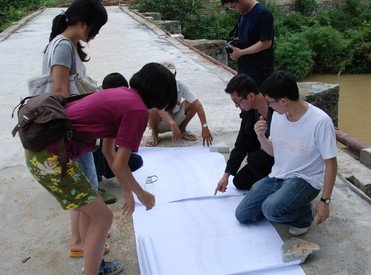Bridging Past and Present
A collapsed village bridge may seem like a straightforward repair job, but for the Department of Architecture it turned out to be a great opportunity to engage with a community in re-creating public space.
A collapsed village bridge may seem like a straightforward repair job, but for the Department of Architecture it turned out to be a great opportunity to engage with a community in re-creating public space.
The bridge in Taiping village in Guizhou had suffered a collapsed arch in 2006 and the Wu Zhi Qiao Bridge Organisation in Hong Kong approached Assistant Professor John Lin to see if he and his students could help to rebuild it.
Mr Lin, however, saw the potential for much more.
"The immediate problem was that the bridge was broken and we had to fix it," he says, "but we tried to expand the problem and to imagine what the bridge could be. Maybe we do something to improve the surface and make it more of a public space."
The bridge is more than 300 years old and at one point was the centre of village life. New developments, including the construction of a nearby highway, had diminished its importance, but people still used it to get to and from settlements on either side, including a middle school.
To determine its future use, HKU architecture students, together with their counterparts from Chongqing University, held numerous meetings with villagers and local government officials to come up with a design that would satisfy all parties.
"The knowledge exchange in this project occurred in all this dialogue we were having. It was really a constant dialogue to try to figure out the best way to preserve the bridge," Mr Lin says.
They decided to use custom-designed pavers to reshape the bridge's broken, muddy surface, so seating and planting areas could be provided, encouraging people to use the space. Stones were recycled from the collapsed section of the bridge and blocks of pre-cast concrete were used in the rebuilding.
"There was the eternal debate that we're dealing with something old, so can we completely restore it? What else can you do with it without taking away its authenticity?"
"The bridge did not always exist in its present form and it has been rebuilt several times over the past 300 years. Our aim was to connect history with what was happening now."
The project was completed in 2009 and received several international architectural awards. More importantly, it served its ultimate goal. "We have photos of kids playing on the bridge dressed in Miao costumes and people think we staged it. But it was a random occurrence – they were coming out of school and using the bridge," Mr Lin says. "It's become a nice place to be."
Mr John Lin received the Faculty Knowledge Exchange Award 2012 of the Faculty of Architecture for the "Taiping Bridge Renovation Project".


